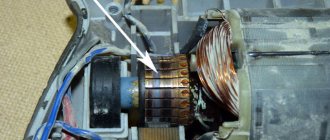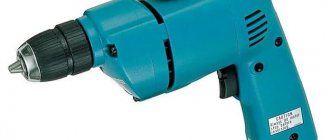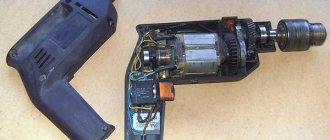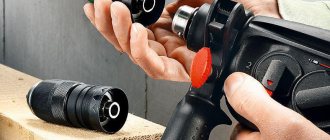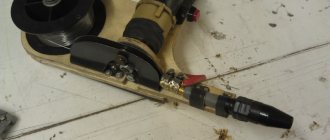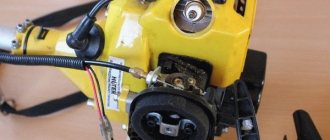Electric motor design and operating principle
The operating principle of an electric motor is based on the interaction of a conductor with a current located in a magnetic field.
The magnetic field is created by the stator.
The main element of its design for a DC motor is a permanent magnet, for alternating current it is an excitation winding. The rotor (armature) has its own winding, to which voltage is supplied using a brush-commutator unit. The interaction of magnetic fields causes the rotor to rotate.
The collector consists of a set of contacts, which are copper plates located directly on the rotor. Micanite or mica cuffs act as insulators for each individual contact. Graphite brushes are sliding contacts pressed against the commutator.
Why do brushes spark in an electric motor?
Sparks, including on a working engine, appear due to mechanical action between the brushes and the commutator. The brush, moving along the commutator from one of its contacts to another, alternately forms and breaks a connection with each of them. Now remember what happens if you unplug any working electrical appliance from the socket - usually at such a moment a spark jumps between the plug and the socket. In the case of a brushed motor, this is the same phenomenon.
Therefore, a small spark even on a working electric motor is acceptable, since connections and ruptures constantly occur here.
Causes
Transient processes occur in the rotor windings due to intermittent mechanical contact of the brushes with the commutator plates, which causes the formation of small arcs.
Important : a fully serviceable engine does not exclude sparking during operation. There are other reasons that cause severe sparking and create the possibility of motor failure.
Brush wear
With prolonged use or poor-quality brush material, they no longer press tightly against the contacts of the commutator. Due to poor contact, the engine does not gain speed or does not start immediately. A worn brush can be easily identified visually.
Sometimes it is not possible to correct the situation by replacing only the worn part. The brush holder and spring should be replaced.
Short circuit in the armature winding
The consequence of such a defect is uneven sparking on the collector. It will be stronger on some plates than others. Due to the presence of an interturn short circuit, the current in certain sections of the rotor winding will be stronger than in others.
Rewinding the rotor or replacing it will eliminate the problem.
Fault in the stator winding
A defect similar to a short circuit in the rotor winding occurs in the stator winding. You can check the presence by measuring the resistance of parts of its windings. If there is a strong difference, it is necessary to rewind the winding or replace it.
Pollution
The product of brush wear is graphite dust, which is an additional source of increased sparking. Dust accumulates between the plates, which creates additional conditions for the formation of sparks. Preventive cleaning of the commutator with sandpaper and removing dirt between the plates will keep it clean.
Brushes not installed correctly
If the brushes are deviated from the norm towards the commutator surface, a significantly larger amount of graphite dust is generated during operation. Misaligned brushes must be corrected.
Poor contact between brushes and commutator
The electric motor spends part of its operating time in overheating mode. Under such conditions, carbon deposits form on the collector. Poor contact leads to increased brush sparking and even more carbon deposits.
You need to use fine-grain sandpaper to clean the surface of the commutator. To increase the stripping effect, use a screwdriver. Clamp the engine rotor into the chuck and remove carbon deposits with sandpaper at low speeds. Afterwards you need to finally polish it on a felt wheel.
Mechanical problems
Mechanical reasons are caused by non-compliance with the requirements of design and technological documentation. Most mechanical causes can be eliminated by turning the manifold on a lathe. Refer this repair operation to a qualified technician. Here are some types of faults that may indicate a breakdown:
- The surface of the collector is uneven;
- The shaft runout exceeds the value specified in the technical documentation;
- Individual collector plates protrude beyond a common level for all;
- Insulation protrusion (mica);
- The brushes in the brush holders move with jamming;
- On the contrary, the brushes are inserted into the brush holders with a large gap, which creates vibration during operation;
- The brush holders are installed far from the commutator;
- Uneven tension of the springs, resulting in a difference in the pressure applied to the brushes.
Sparks, smoke, crunching and burning smell: what can break in a drill or screwdriver
Quick drill diagnostics
To find out exactly why your drill broke or what’s wrong with your screwdriver, you need to take the tool to a service center for diagnostics. But there are many direct and indirect signs that can be used to roughly determine which node has problems.
- If the drill does not turn on at all (and does not even hum), then the problems are almost one hundred percent hidden in the electrical part. Moreover, the problem can be of any scale: from the funny (clogged contacts on the button) to the major (burnout of the engine or electronic control unit).
- If the power tool works poorly, intermittently, and sparks desperately, then the problem is most likely in the armature, commutator or brushes area. It is with the commutator-brush assembly that most malfunctions are associated, due to which drills and screwdrivers do not work as well as expected of them.
- If during operation strange sounds appear that were not there before (squeaking, crunching, howling), or strange vibrations and beatings appear, then the problem is probably related to the mechanical part. For example, bearings can “squeal”, gears can “crunch”, and a shaft or cartridge can “knock”.
- If the drill motor hums and the chuck does not rotate, then the reason is probably a broken gearbox or a jammed shaft. A faulty gearbox and a sticking shaft can also cause the drill to not turn the drill as fast as we would like, or the screwdriver to not rotate the bit with the force it should be.
- If the power of the drill drops for no apparent reason, this may be due to increased losses: mechanical or electrical. In some cases, the cause of the loss of power may be clogged bearings that do not rotate as freely as before. Sometimes the problem lies in burnt armature windings, due to which the resistance in the circuit increases and the engine becomes unable to develop its rated power.
- If the drill overheats, smokes or smells burnt, then the problem could be anything: mechanical, electrical, clogging, wear, or simple damage due to careless operation. Often the reason also lies in the fact that someone decided to “push the heat” and subjected the tool to loads for which it was simply not designed.
So, we briefly figured out why a drill, screwdriver or hammer drill may not work well. Next, we will look at the typical causes of malfunctions in more detail and divide them into several categories: from easily fixed problems to cases where repair is impractical.
| Small Makita screwdriver disassembled. |
Not a breakdown at all
Some problems with drills and screwdrivers cannot even be called malfunctions. Such annoying troubles include wear of the commutator brushes. Graphite brushes are a consumable item (sometimes drills are sold with a spare set). They are more or less standardized, often interchangeable (the running sizes fit tools of different brands) and cost literally pennies. In many drills, you don’t even need to open the housing to replace the brushes. This can be done without disassembling the power tool if the manufacturer has provided special windows covered with plugs for access inside. Powerful power tools, like rotary hammers, even come with indicators that tell you when it's time to replace the carbon brushes.
Popular screwdrivers DeWALT DCF887N from RUR 8,327 Makita DTD171Z from RUR 11,460 Makita TD110DZ from 3,800 rub. Bosch GDR 120-LI Professional 06019F0000 from RUR 3,853 DeWALT DCF801D2 from RUR 16,390 Makita DTD152Z from RUR 4,929 Makita TD110DWAE from RUR 9,920 Worx WX291 from RUR 5,590 Makita TD0101F from RUR 5,550 DeWALT DCF887P2 from RUR 31,864. Bort BSM-300I from RUR 2,740 Makita DF033DZ from 3,170 rub. Bosch GSR 12V-35 HX Professional 06019J9101 from RUR 11,908 Ryobi RID1801M from RUR 4,804 Makita DTD155Z from RUR 7,530 Makita TD001GZ from RUR 14,590 DeWALT DCF620D2K from RUR 21,280 Bort BAB-12x2LI-FDK from RUR 3,180 Makita DTD153Z from RUR 7,190 DeWALT DCF809D2T from RUR 20,535
If there is no indicator, then the brushes themselves will let those who are unwary know that they are worn out. The most obvious (literally and figuratively) sign of wear is the powerful sparks that are visible through the housing slots and ventilation holes. An indirect sign is the operation of the tool intermittently and jerkily. Sparking occurs due to the fact that the brushes are not fully pressed against the commutator by the springs. Sparking is accompanied by the release of heat. In addition to the smoke and burning smell that accompany sparks, the danger lies in the fact that due to overheating, the collector plates can become deformed and become unsoldered from the base of the collector. That is, without changing the brushes in time, you can easily “screw up” the motor armature.
| The process of replacing brushes using the example of a DeWALT screwdriver. |
The “visual effects” described above almost never occur with drills and screwdrivers with brushless motors. In general, they have many advantages over tools with traditional motors (though the price is considerable). If something sparks slightly inside the brushless screwdriver under load, then it is the motor brake (and this is quite normal, not a malfunction).
Popular drills
Interskol DU-13/780ER 421.1.0.00 from 2,493 rub. Interskol DU-22/1200ERP2 330.1.0.00 from 5,932 rub. Makita HP1640 from RUR 3,799 Bosch GSB 16 RE Professional 060114E500 from RUR 7,826 Metabo SBE 650 600671510 from RUR 5,809 Bosch GSB 13 RE Professional 0601217100 from RUR 3,699 DEKO DKID650W 063-4085 from RUR 1,199 Makita 6413 from RUR 3,165 Interskol DU-16/1000ER 57.1.3.00 from 4,290 rub. Bosch GSB 1600 RE Professional 0601218121 from RUR 5,213 Interskol DU-16/1050ER 149.1.3.00 from 4,289 rub. PIT PSB 13-C2 from RUR 1,579 Makita HP1640K from 4,400 rub. Bosch GSB 13 RE Professional 0601217102 from RUR 3,468 Makita HP2050 from RUR 7,530 Interskol D-10/420E 672.1.0.00 from 1,568 rub. Makita HP1630K from RUR 5,050 Bort BSM-1100 from RUR 3,730 DeWALT DCD740N from RUR 10,601 AEG BE 750R from RUR 5,509
Almost no breakdowns
There are also problems that only look scary, but can be easily fixed on your own with a screwdriver, sandpaper and a few strong words to the tool manufacturer.
- If the drill just won't turn on, start by checking the wire. Usually the cable frays near the plug or (which happens more often) at the entrance to the handle. The power cable can be easily and quickly replaced with any other one with the same core cross-section. If the problem is not the power cable, then it's time to open the case and check the internal wiring. It happens that the wires inside the drill come off or are unsoldered if the manufacturer does not pay due attention to quality control of their products.
- Difficulties in turning on a drill or screwdriver may be due to clogged buttons and contacts. All switches are affected by this: the start button, the speed control and the reverse slider. If they stick or move slowly, then you should open the tool and thoroughly clean it of dust, blowing it with compressed air. All contacts should be thoroughly wiped with alcohol and cleaned with fine, fine-grained sandpaper. This is quite a troublesome job (after all, the contacts and parts of the buttons are so small).
- Sometimes the drill chuck does not hold well, and the equipment dangles in it. It often happens that the ring gear is worn out, and it is impossible to tighten the drill properly with a wrench. These problems can be eliminated in one and only way - by replacing the cartridge.
- If a new drill smells like a car exhaust when you first turn it on, this is not always a sign of a serious problem. This happens if there is too much lubricant in the gearbox or bearings. Being forced out through the cracks and falling on the heated parts of the instrument, the excess grease burns and gives off a characteristic odor. The problem is solved by disassembling the tool (with loss of warranty) and removing excess lubricant.
| Bosch cordless screwdriver disassembled. |
Serious trouble
Some malfunctions, unlike those described above, can cause a lot of trouble and cost a pretty penny.
Excessive heating of the drill bearings (which can sometimes be recognized by smoke and the smell of burning plastic, as well as tight rotation of the chuck and a loud “squeaking”) indicates serious problems. A part heated red-hot can melt the plastic body of the tool. When melted, the plastic will lose its shape and significant play will appear in the parts. If the bearing is not lubricated or replaced, then over time it will collapse from overheating, or the armature will jam. Until it breaks into pieces, it will ruin your nerves with a loud howl and take away some of the engine power.
If the impact drill stops taking concrete and brick, this means that its impact mechanism has completely worn out. An electric drill is designed differently from a hammer drill. Instead of a “drunk” bearing or crank mechanism, it has two ratchets with wavy surfaces that slide against each other, allowing the drill to strike the concrete lightly. Over time, these “waves” naturally wear out, the ratchets turn into flat washers, and the drill or screwdriver that was previously able to drill into concrete turns into a regular hammerless tool. It is possible to restore operation in hammer drilling mode only by repairing and replacing worn parts. Therefore, if you need to drill concrete not from time to time, but regularly, then it is better to immediately buy a normal hammer drill.
| Bosch three-mode rotary hammer in disassembled form. |
Almost hopeless cases
Serious damage to engines and gearboxes is almost a “sentence.” We use the word “almost” because repairs that completely restore the functionality of the instrument are still possible. But sometimes (especially in the case of brushless power tools) the cost of repair is comparable to the price of a new device.
The reasons for engine failure may be:
- defective or initially poor quality - motors whose windings are wound from too thin or low-quality copper wire simply cannot withstand long-term operation or heavy loads and burn out, emitting the spirit in the form of thick bluish smoke;
- insulation failure and short circuit - the “armor” of the electric motor (that is, the heat-resistant varnish with which the windings are generously coated) can be damaged as a result of exposure to abrasive particles (dust, metal particles, small concrete chips) that get inside the drill body during operation.
Drill gearboxes break due to poor quality metal, unhardened gears, lack of lubrication, or (which happens much more often) due to excessive loads. If the splines on the shaft are “licked” or the teeth of the gear are broken off, then the entire assembly must be rebuilt or replaced entirely. It is better not to disassemble the planetary gearbox of a drill or screwdriver on your own (except in cases where only the lubricant is replaced), because it contains a lot of small parts: gears, washers and seals.
| Kobalt brushless screwdriver disassembled. |
Let's sum it up
There are many reasons why a power tool may spark, smoke, hum, or vibrate when used. Many of them are associated with improper operation and excessive loads. Therefore, you need to choose screwdrivers and drills correctly, based on specific tasks and working conditions. And if you just need a good tool, then you should pay attention to products from Bosch, DeWALT, Makita, Metabo, AEG or another company with an excellent reputation. The listed manufacturers have service centers in almost every region of the country, and you can buy spare parts for drills and screwdrivers of these brands almost freely.
